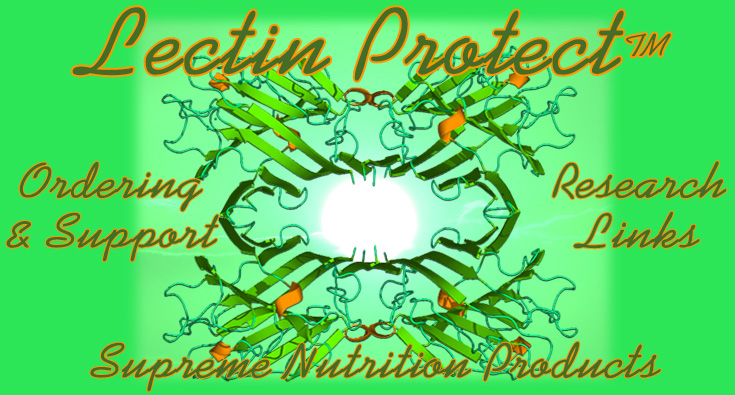
The issue of lectins has become more well know recently due to the work of Steven Gundry MD and others. For your chronic patient lowering the lectin load in the diet as well as taking lectin binding agents can make major shifts in your patients’ health.
Lectins are carbohydrate binding proteins found in your foods. Though they probably exist in all foods to some extent, they are highest in beans, grains, grain and bean fed animal products, nuts and seeds, and nightshades.
Lectins are resistant to breakdown by the body’s digestive enzymes and to most methods of cooking. Eating them in excess or even in small amounts in susceptible people can contribute to a myriad of health problems (especially in patients with dysbiosis and/or food sensitivities).
They are a major contributor to increased intestinal permeability (“leaky gut”) (1). As a result of leaky gut they can enter the bloodstream, react with antibodies and lead to various autoimmune “diseases” depending on your weakened areas, genetics, etc. One study showed specifically how they interact with enterocytes and lymphocytes, leading to antigenic stimulation, and cause the expression of rheumatoid arthritis (2). They can also make your body more prone to dysbiosis.
Many lectins are toxic to the nervous system, immune system, etc. Some, like the lectins in raw kidney beans, can lead to death. Hypercoagulation, and endocrine disruption are other possible side effects of eating lectins.
Dr. Gundry has stated in his book Plant Paradox that lectin reduction in his practice has helped such diverse conditions as arthritis, chronic fatigue, dementia, depression, heart disease, diabetes, migraines, PCOS, obesity, etc., etc., etc.
Avoiding all lectins is impossible but it is advisable to decrease your exposure.
There are a few lectin binding protects on the market. We decided to look at the research and buy samples of all the whole natural substances that appear to have lectin binding properties and with blind applied kinesiology testing find out which ones perform the best. We have done that and as a result have come out with the product Lectin Protect. We always feel that the simpler the product is the better. Lectin Protect has three ingredients: Bladderwrack, Okra, and Larch bark.
Bladderwrack (fucus vesiculosus) contains fucose sugars, whose mucilaginous properties appear to bind to harmful lectins and eliminate them from the body (3, 4, 5). It can also help eliminate pathogenic organisms from the gastrointestinal tract (6).
Okra has similar properties and can bind lectins in food as well as those already attached to various receptor sites. One study showed that Okra bound up to 80% of certain types of lectins (7).
Larch bark is naturally high in arabinogalactans and can help bind not only lectins but block lectin binding sites in the body (8, 9). Arabinogalactans have also been shown to help protect one against the common cold and stimulate the immune system to fight off infections (10, 11).
Contraindications:
Consult your physician if you have a bleeding disorder, hyperthyroidism, are pregnant, trying to get pregnant, or have had an organ transplant.
Recommended dosage:
2 capsules 3x per day for the first bottle, with meals. After that take 2 with each meal that contains higher lectin foods (beans, grains, nightshades, seeds, and grain fed animal products)
References:
1. De Punder, Karin, and Leo Pruimboom. "The dietary intake of wheat and other cereal grains and their role in inflammation." Nutrients 5.3 (2013): 771-787.
2. Cordain, Loren, et al. "Modulation of immune function by dietary lectins in rheumatoid arthritis." British Journal of Nutrition 83.3 (2000): 207-217.
3. Kornfeld, Kerry, Marc L. Reitman, and Rosalind Kornfeld. "The carbohydrate-binding specificity of pea and lentil lectins. Fucose is an important determinant." Journal of Biological Chemistry 256.13 (1981): 6633-6640.
4. Holthöfer, H., et al. "Ulex europaeus I lectin as a marker for vascular endothelium in human tissues." Laboratory investigation; a journal of technical methods and pathology 47.1 (1982): 60-66.
5. Matsumura, Kengo, et al. "Carbohydrate Binding Specificity of a Fucose-specific Lectin from Aspergillus oryzae A NOVEL PROBE FOR CORE FUCOSE." Journal of Biological Chemistry 282.21 (2007): 15700-15708.
6. Pham, Tu Anh N., et al. "Epithelial IL-22RA1-mediated fucosylation promotes intestinal colonization resistance to an opportunistic pathogen." Cell host & microbe 16.4 (2014): 504-516.
7. Wu, Albert M., et al. "Characterization of the okra mucilage by interaction with Gal, Ga1NAc and GlcNAc specific lectins." Biochimica et Biophysica Acta (BBA)-General Subjects 1243.2 (1995): 157-160.
8. Beuth, J., et al. "Inhibition of liver tumor cell colonization in two animal tumor models by lectin blocking with D-galactose or arabinogalactan." Clinical and Experimental Metastasis 6.2 (1988): 115-120.
9. Beuth, J., et al. "Inhibition of liver metastasis in mice by blocking hepatocyte lectins with arabinogalactan infusions and D-galactose." Journal of cancer research and clinical oncology 113.1 (1987): 51-55.
10. Riede, L., B. Grube, and J. Gruenwald. "Larch arabinogalactan effects on reducing incidence of upper respiratory infections." Current medical research and opinion 29.3 (2013): 251-258.
11. Kelly, Gregory S. "Larch arabinogalactan: clinical relevance of a novel immune-enhancing polysaccharide." Alternative medicine review: a journal of clinical therapeutic 4.2 (1999): 96-103.